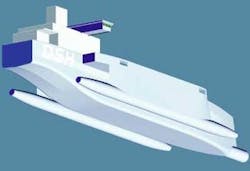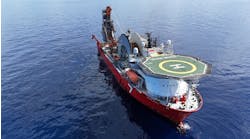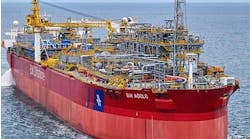Trimaran proposed to pump oil slicks
The Oil Sea Harvester is a new anti-pollution trimaran that could store 6,000 tons of oil. Christian Gaudin, a French naval architect at Les Chantiers de l'Atlantique, proposed the construction of the vessel, which measures 445 ft long and 105 ft wide.
The aim is to design a vessel capable of responding more quickly and effectively to oil spills. The design addresses the shortcomings in existing systems, which became apparent during the sinking of the Erika off the coast of Brittany in 1999. The new trimaran offers the ability to operate in open seas during bad weather, unlike present vessels, and provides increased storage capacity. Les Chantiers de l'Atlantique, a subsidiary of Alstom Marine, with funding from France's Committee for Oil and Marine Research, and support from French Center for Documentation, Research, and Experimentation on Accidental Water Pollution, recently carried out preliminary design work on the OSH.
OSH has a trimaran structure with a central hull, a large slender monohull, and two small waterplane area twin hull-type side hulls. This design gives the vessel a number of advantages, including directional, pitch, and roll stability. These advantages enable it to operate in open seas without support and to withstand seas up to force 7 while providing two, 26-ft-wide channels of calmer water between its hulls. This design means the oil slick will remain confined between the side hulls and the central hull. High performance recovery equipment, appropriate for the type of spill, is placed within the two channels. The equipment may consist of a cyclonet centrifuge system, scoops, bucket wheels or traditional pumps. These different modular techniques can be chosen according to the viscosity of the product ascertained on site.
The central monohull will be able to store up to 6,000 tons of oil, which is equal to its daily collection capacity. Its total capacity, taking into account distances and transfers, is estimated at 20,000 tons per week. The trimaran would also carry tools and machinery for treating the oil such as filtration, decantation, reheating, and chemical processing equipment, all optional depending on the problem to be resolved.
The vessel's range of operation is another key component to this design because it must respond quickly to remote spill sites. Fitted with two pods (engines in nacelles), each with a power of 10 MW, the cruising speed of the trimaran would be 20 knots. This speed would enable the OSH to respond rapidly to a problem anywhere off the European coast. During the collection phase, speed would drop to 3 knots.
If the OSH had been built before November 2002, it would have taken only one to two days to travel from its home port in Brittany, France, to the locations of the sunken tanker Prestige off the Spanish coast.
Yves Tallec, project leader, estimates that the cost of building the vessel would be about ¤100 million. Its size, sea state capability, and power make it possible to consider tasks other than recovering oil, such as search or rescue missions, maritime surveillance, recovering solid waste, recovering chemical products, fire fighting, and offshore operations.
Subsea wellhead retrieval system
The Baker Oil Tools Tension Cut and Pull subsea wellhead retrieval system can reduce the number of trips needed to recover intermediate casing strings and wellhead from the seabed. The system is designed to engage any manufacturer's wellhead, cut conductors in tension, and recover the wellhead from the seabed in a single trip. According to BOT Fishing Product Line Manager James Sonnier, deepwater operators will reduce the number of trips using this system and save rig time and operating expenses. In addition to improving efficiency on deepwater operations, this system uses all hydraulically operated components, improving safety and reliability. The system requires no motors or explosives.
SenCorr for Thunder Horse
CorrOcean Inc. has been awarded a $1.3-million contract by FMC Energy Systems to provide its high-accuracy digital subsea SenCorr pressure and temperature, and sand erosion sensor systems. This is in addition to a previous order for the same type of sensors in 2002 for $400,000. The sensors will be deployed on the subsea trees for BP's Thunder Horse development in the US Gulf of Mexico. Located in the deepwater Mississippi Canyon area, Thunder Horse is in over 6,000 ft water depth, at the limit of current subsea production technology.
Dave Rees, president of CorrOcean Inc. in Houston, said his company has received several other contracts for innovative sensor technology to be deployed on Thunder Horse. This equipment includes subsea corrosion monitoring using the field signature method (FSM) system; both electrical resistance and FSM technologies on the platform's process pipe work for topside sand erosion monitoring and corrosion monitoring, and, most recently, response modeling of the infield production steel catenary risers.
BJ lands hammer contract
BJ Tubular Services has completed its first hammer services contract for European Marine Contractors Ltd. The underwater pile driving and pile handling services were carried out in the Southern North Sea by the BJ Hammer Services division based in Great Yarmouth. Further projects scheduled to begin in 2003 are currently in the planning stages.
BJ uses a hydraulic pile driving system known as the IHC Hydrohammer to drive conductors and pipe into the earth creating a foundation for a new oil or gas well. Designed for driving piles on or offshore, the Hydrohammer can also be used to efficiently drive large piles for the purpose of constructing buildings or bridges. The Hydrohammer delivers precise, concentrated blows to the piling column, driving piles deeper and faster than other systems. In addition, the process is extremely safe. The Hydrohammer is equipped with a safety feature that automatically shuts the system down should a pile penetrate ahead of the hammer, blow energy is set too high, or the system is positioned incorrectly.




